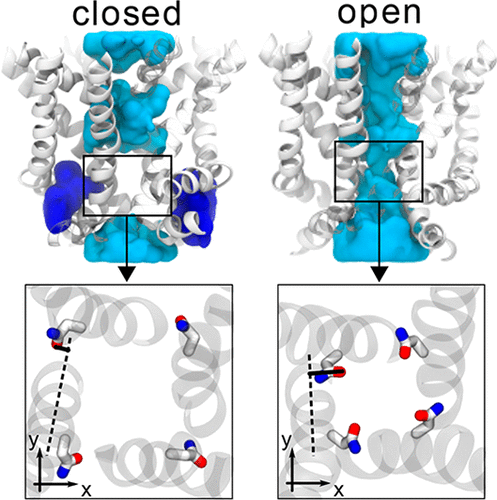当前位置:
X-MOL 学术
›
J. Phys. Chem. Lett.
›
论文详情
Our official English website, www.x-mol.net, welcomes your
feedback! (Note: you will need to create a separate account there.)
Ion Channel Sensing: Are Fluctuations the Crux of the Matter?
The Journal of Physical Chemistry Letters ( IF 4.8 ) Pub Date : 2018-02-13 00:00:00 , DOI: 10.1021/acs.jpclett.7b03396 Marina A Kasimova 1 , Aysenur Yazici 2 , Yevgen Yudin 2 , Daniele Granata 1 , Michael L Klein 1 , Tibor Rohacs 2 , Vincenzo Carnevale 1
The Journal of Physical Chemistry Letters ( IF 4.8 ) Pub Date : 2018-02-13 00:00:00 , DOI: 10.1021/acs.jpclett.7b03396 Marina A Kasimova 1 , Aysenur Yazici 2 , Yevgen Yudin 2 , Daniele Granata 1 , Michael L Klein 1 , Tibor Rohacs 2 , Vincenzo Carnevale 1
Affiliation

|
The nonselective cation channel TRPV1 is responsible for transducing noxious stimuli into action potentials propagating through peripheral nerves. It is activated by temperatures greater than 43 °C, while remaining completely nonconductive at temperatures lower than this threshold. The origin of this sharp response, which makes TRPV1 a biological temperature sensor, is not understood. Here we used molecular dynamics simulations and free energy calculations to characterize the molecular determinants of the transition between nonconductive and conductive states. We found that hydration of the pore and thus ion permeation depends critically on the polar character of its molecular surface: in this narrow hydrophobic enclosure, the motion of a polar side-chain is sufficient to stabilize either the dry or wet state. The conformation of this side-chain is in turn coupled to the hydration state of four peripheral cavities, which undergo a dewetting transition at the activation temperature.
中文翻译:

离子通道传感:波动是问题的关键吗?
非选择性阳离子通道 TRPV1 负责将有害刺激转化为通过周围神经传播的动作电位。它在高于 43 °C 的温度下被激活,而在低于此阈值的温度下保持完全不导电。这种使 TRPV1 成为生物温度传感器的剧烈反应的起源尚不清楚。在这里,我们使用分子动力学模拟和自由能计算来表征非导电和导电状态之间转变的分子决定因素。我们发现孔的水合作用和离子渗透主要取决于其分子表面的极性特征:在这个狭窄的疏水外壳中,极性侧链的运动足以稳定干态或湿态。
更新日期:2018-02-13
中文翻译:

离子通道传感:波动是问题的关键吗?
非选择性阳离子通道 TRPV1 负责将有害刺激转化为通过周围神经传播的动作电位。它在高于 43 °C 的温度下被激活,而在低于此阈值的温度下保持完全不导电。这种使 TRPV1 成为生物温度传感器的剧烈反应的起源尚不清楚。在这里,我们使用分子动力学模拟和自由能计算来表征非导电和导电状态之间转变的分子决定因素。我们发现孔的水合作用和离子渗透主要取决于其分子表面的极性特征:在这个狭窄的疏水外壳中,极性侧链的运动足以稳定干态或湿态。











































 京公网安备 11010802027423号
京公网安备 11010802027423号